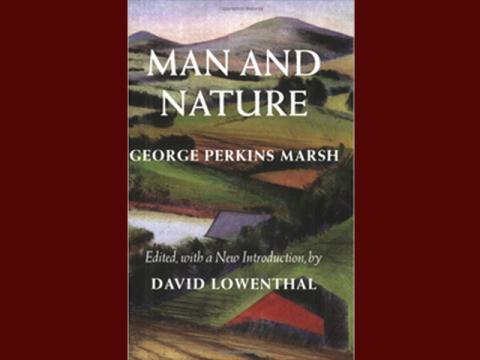Man and Nature: Finding Our Roots in the Natural World

A wealth of great writing exists on the environment, good conservation practices, and natural resources stewardship. One classic of American environmental writing is Man and Nature, a book by George Perkins Marsh first published in 1864 and considered essential to an understanding of American attitudes toward the natural environment.
Any one of us might be attracted to a book with this title were we to come across it on a library shelf. But paging through Marsh’s work, the full title of which is Man and Nature; or, Physical Geography as Modified by Human Action, might give us pause. Dipping into the dense text here and there, noting the lengthy footnotes that in some instances consume two-thirds of a page, and seeing paragraphs filled with numerical data, we might quickly decide to return the nearly 500-page volume to the shelf.
This may be understandable, but at the same time, even if we don’t read it from cover to cover, this is a book with which we should all be familiar. Yes, the writing can be dense and mannered. And the index includes nothing about global warming, the proliferation of waste in our oceans, and the other issues that deeply trouble so many of us today. But, as has been argued convincingly in many places, Man and Nature is a foundational text of American environmental consciousness. As such it is a critical part of our heritage as individuals who care deeply about the natural world.
First published in 1864, Man and Nature provides informative descriptions of the conditions of the natural environment in North America at that time. It also offers insights into the first stirrings of new American attitudes toward nature. The middle decades of the 19th century, which witnessed the sectional clash that led to the Civil War, were a time when open land and resources, once thought to be inexhaustible, were revealed to have limits. It became apparent to some that a culture and an economy based on a ready supply of boundless natural resources was flawed.
Marsh coupled this realization with the apprehension that human actions were causing great and, in some cases, irreversible damage to natural environment. Settlement in the country’s interior western territories that would be further spurred by the signing of the Homestead Act in 1862, added urgency to his concerns. But those who saw our resources to be finite and endangered were a minority and Marsh was unsparing in criticizing the many who continued to act as though this was not the case. “Man has too long forgotten that the earth was given to him for usufruct alone, not for consumption, still less for profligate waste.”
Marsh’s perspective on America’s natural resources was informed by broad experience and travel, a deep curiosity, and wide-ranging research, all driven by a sharp intellect. He discerned a stark contrast between the natural environment in Europe and that in North America. He found the former to be seriously degraded by centuries of abuse, especially when compared with that which remained free of development in America. At the same time he admired the extensive studies of the natural environment and experiments with its restoration that had been carried out, especially in France, and expressed the hope that in the United States the Smithsonian Institution would undertake comparable research, especially in those regions that had not yet felt the impact of development. He also held out hope that Americans, learning from their ancestors’ failings, might demonstrate an ethic of enlightened stewardship of their lands and seek to restore those that had already been compromised by settlement practices and industrial exploitation.
Perhaps Marsh’s greatest contribution to American environmental thought was his rigorous two-fold assessment of the connections between human activities and the natural environment. He sought to identify and even quantify the direct consequences of human activities on the natural environment. And he recognized and described the interrelationships he found between the impacts of those activities on different parts of the environment. This ambitious and at that time novel project is reflected in the structure and organization of Man and Nature.
Marsh divided his manuscript into six chapters. The centerpiece, both physically and in terms of his argument, is chapter three which is devoted to The Woods. Comprising more than a third of the book, this chapter explores the subject from varied perspectives, all grounded in a searing pessimism about humans’ relationship to woodlands. “The destruction of the woods, then, was man’s first physical conquest, his first violation of the harmonies of inanimate nature.” Among the topics covered in the chapter are discussions of what constitutes a woodland, how woods have been impacted by different destructive forces and events, how they can be restored, the multiple functions they have in a complex environmental system, and how woods influence climate.
The chapter provides detailed descriptions of the impacts of consumptive practices not only on forests but on soil, water resources, and virtually every other element of the natural environment. He links the loss of the fertility of certain agricultural lands to the deforestation of mountainsides higher in the watersheds that feed them, for example. Succeeding chapters on The Waters and The Sands add further information to build the case for the thoughtful maintenance and even restoration of woodlands. Today we may take these interrelationships for granted, but in the middle of the 19th century they were nothing short of revolutionary.
When discussing North America’s woodlands within the chapter, Marsh describes the state of American forests at the time he was writing. He acknowledges the positive aspects of the practices of Native Americans who populated the continent before the arrival of Europeans and then identifies changes to the continent’s forests that began with the arrival of colonists in the seventeenth century. He also identifies a range of negative impacts of certain agricultural practices employed by American farmers. But most of all, in this chapter and throughout the book, he offers biting criticism of Americans’ attitudes toward the natural environment.
From his own words, we know that Marsh wrote Man and Nature for a general educated audience, not for specialists. It received a warm reception when published and was reprinted, translated, and later revised by the author. Reading it today we find things that demonstrate the limits of knowledge at the time it was written. Early in Chapter Three, The Woods, for example, Marsh describes the belief that the maintenance of trees in certain locales in Italy afforded protection from malaria which at that time was attributed to “miasmastic exhalations” from marshy wetlands, not the mosquitoes that thrived in them. But the text, and especially those discursive footnotes, also impart knowledge that we are likely to have lost over the last century and a half. One lengthy example begins by commenting on English jurisprudence only to wrap up several paragraphs later describing the derivation of the American term “bee line.” Providing welcome asides while reading Man and Nature, these also offer intriguing glimpses of other dimensions of Marsh’s personality.
Marsh’s book exists in various editions. The 2003 University of Washington Press edition, part of the Weyerhauser Environmental Classics series, is worthy of special note. This is essentially the original 1864 text as edited in the 1960s by the geographer David Lowenthal. It includes a foreword by environmental historian William Cronon and informative preliminary sections by Lowenthal. In addition, Lowenthal provides clarifications and additional information throughout the text. For those interested in learning more about Marsh, Lowenthal was also the author of the major biography, George Perkins Marsh: Profit of Conservation. It, too, was published by the University of Washington Press in 2003 and has a spot on my “to be read” list.
Inclusion or exclusion of commercial names, logos, products or services does not equate or imply endorsement by Cooperative Extension or the University of New Hampshire.

